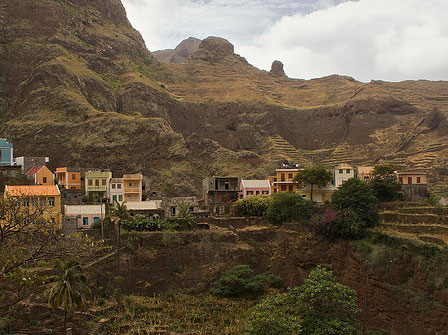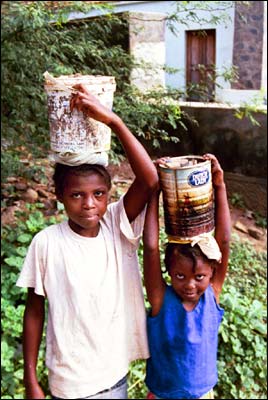Lesson: Harvest Water from Fog
 (Lesson courtesy Peace Corps’ Paul D. Coverdell World Wise Schools)
(Lesson courtesy Peace Corps’ Paul D. Coverdell World Wise Schools)
Level: Grades 4-12.
Time Required: One to two class periods.
Update 3/2019: The Peace Corps’ educator resources site has changed, so some links may no longer function.
Overview
In this lesson from the Peace Corps, students in grades 4-12 learn how harvesting water from fog can help people who have limited access to fresh water. They study the water challenges in Cape Verde, and the technology and benefits of fog water collectors. They then build and evaluate a own working model.
Objectives
Students will:
- Become familiar with the concept of water being harvested from fog
- Explore the Peace Corps project site by watching Nathan Lee’s video
- Create a model fog collector
- Discuss possible solutions to the lack of fresh water
 Framework and Standards
Framework and Standards
Enduring Understandings
- We all need fresh water to survive.
- Fresh water can be collected from some unusual places.
Essential Questions
- Where do we find fresh water?
- What can those living in Cape Verde do to increase the amount of fresh water?
Science Standards
- Standard 5 – Earth and space science
- Standard 7 – Science in personal and social perspectives
Background Information
The people of The Republic of Cape Verde, an island nation located about 300 miles off the western coast of Africa, enjoy warm temperatures and a beautiful setting. Yet, finding enough water to drink and use within homes continues to be a challenge, particularly with a lack of rainfall. Collecting water from the rolling fog that sweeps over the islands has proven to be not only innovative, but also very successful. The high elevation of the Monte Gordo Natural Park has exposure to prevailing winds, and an abundance of fog. These conditions make it an ideal location for harvesting water from fog. Nathan Lee and his team will introduce students to their project through videos and photos.
About Cape Verde
- Peace Corps — Where Do Volunteers Go? — Cape Verde
- Peace Corps — 8 projects to bring water to communities
- Peace Corps — World Wise Schools — Water in Africa
- CIA – The World Factbook — Cape Verde
Materials
- Featured Reading: Fog’s Bounty: Harvesting Water From Fog by Nathan Lee
- Country photos provided on the Water in Africa website
- Video of the Peace Corps fog collecting project at Monte Gordo Natural Park
- Related Publication: Slide show | Fog’s Bounty: Harvesting Water From Fog
Vocabulary
- Africa: One of the largest continents on Earth. It has 53 countries and is known for many things including large deserts and many animals.
- Cape Verde: The Republic of Cape Verde is an island nation located about 300 miles off the western coast of Africa.
- Fog nets: An apparatus made up of fine mesh for collecting liquid water from fog.
Procedure
INTRODUCTION
1. Introduce the topic of harvesting water from fog by discussing the physical characteristics of fog and low cloud cover.
2. Create a discussion around the benefits of collecting water from fog – including:
- System requires no energy input to operate
- Multiple uses for water; including drinking, irrigation, and reforestation
- Reduces the burden of carrying water from distant sources
- Ideal for many locations where fog is abundant while rain is not
- System is easy to construct, and expandable as needed
- Atmospheric fog water is clean and abundant
3. Have your students read the brief narrative, Fog’s Bounty: Harvesting Water From Fog by Peace Corps volunteer, Nathan Lee, and then watch the video of the Peace Corps project at Monte Gordo Natural Park in Cape Verde. Afterwards, have them discuss how the system works.
4. Dividing students into small groups, supply each with a set of materials, and provide them with the instructions for creating this simple fog collector, below.
ACTIVITY: BUILD A FOG COLLECTOR (see the original activity description here)
- Panty Hose
- Wire coat hanger
- Coffee can or other container
- Sand or rocks to weight the container
- Humidifier — inexpensive models can be purchased at a drug store for around $30.00
1. Stretch a wire coat hanger out to form a diamond (as seen in the picture).
2. Place the panty hose around the wire coat hanger frame (this will represent the netting of a fog collection net).
3. Bend the hook of the wire hanger until it is straight.
4. Hold the coat hanger upside down and place the straightened-out hook into a coffee can filled with sand.
5. Using the humidifier, direct the steam or mist towards the fog net. The water droplets should form on the netting of the panty hose and run down into the coffee can. If the humidifier does not produce enough moisture, you can use a water bottle and spray the netting instead.
Evaluation
Have students discuss the video, as well as their observations of the results of the hands-on activity. In addition to the nets, what else did Nathan Lee and his group devise to help capture, transport, and purify the water? What kind of system would engineers need to develop a system that could supply the water needs of an entire neighborhood or village? Is this a promising method for collecting water? What its advantages and disadvantages?
Extensions
- Students who live in an environment with natural and regular fog can take the constructed fog collectors outdoors, monitoring them over a length of time, and measuring the amount of water collected.
- Explore other methods Peace Corps Volunteers have used to get fresh water in Cape Verde in a slide show about the use of solar stills and the related lesson plan of building a solar still.
- Have students start a correspondence with a Peace Corps volunteer in Cape Verde or Africa through the Coverdell World Wise Schools Correspondence Match Program.
Image credits: Fontainhaus, Cape Verde by Richard Leeming. http://www.flickr.com/photos/dickdotcom/3222787323; Girls Collecting Water from Water in Africa by Brandon Lundy, São Domingos, Cape Verde (1999).
Filed under: Grades 6-8, Grades 9-12, Grades K-5, Lesson Plans
Tags: Clean Water, Environmental Engineering, Grades 4-12, Peace Corps Cape Verde, Water









